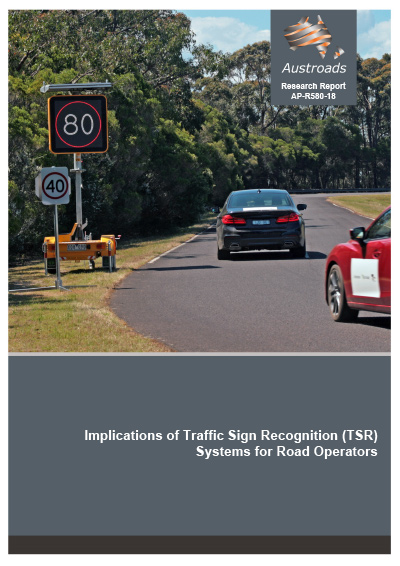Connected and Automated Vehicles

- Publication no: AP-R580-18
- ISBN: 978-1-925671-71-1
- Published: 22 August 2018
- PDF (free) Download
Traffic Sign Recognition (TSR) is an in-vehicle technology which attempts to read and interpret roadside traffic signs. Vehicle manufacturers are moving towards enabling speed assistance and automated driving using TSR systems and the benefits of successful introduction are likely to be significant for road safety.
This report investigates the potential changes needed to Australian and New Zealand traffic signs to consistently support and optimise the outcomes from the introduction of TSR systems. The report captures evidence to support findings and recommendations through three sub-investigations:
- Reviews of literature relating to TSR systems and Australian and New Zealand road signage
- Stakeholder interviews with vehicle manufacturers and key technical committees for traffic signs
- On-road and off-road evaluations using a range of modern vehicles.
The report concludes with specific recommendations for changes to enhance traffic sign readability across electronic signs, installation and maintenance, sign positioning and location, sign face design, vehicle mounted signs, and other advisory and information signs.
- Executive Summary
- Project aims and method
- Key Findings
- Major recommendations
- Contents
- 1. Introduction
- 1.1 Study objectives
- 1.1.1 Current deployment status of TSR systems in Australia and New Zealand
- 1.1.2 Benefits of TSR technology
- 1.1.3 Australasian New Car Assessment Program (ANCAP) protocols
- 1.1.4 Issues with adapting TSR systems to Australia and New Zealand
- 1.2 Austroads project scope
- 1.2.1 Out of scope
- 1.1 Study objectives
- 2. Literature Review
- 2.1 TSR system architecture
- 2.1.1 Image analysis processes
- 2.1.2 TSR systems as part of ADAS and automated driving
- 2.1.3 Technical specifications
- 2.1.4 Current performance and limitations
- 2.2 Review of traffic signs practices
- 2.2.1 International practices
- 2.2.2 Australian standards and Austroads guidelines
- 2.2.3 New Zealand standards
- 2.2.4 Electronic signage
- 2.2.5 Sign placement
- 2.2.6 Maintenance guidelines
- 2.2.7 Sign approvals and processes/governance
- 2.3 Design standards
- 2.3.1 Maximum speed restriction signs
- 2.3.2 Minimum speed restriction signs
- 2.3.3 End of speed restriction signs
- 2.3.4 Speed restriction ahead signs
- 2.3.5 Speed derestriction signs
- 2.3.6 Speed advisory signs
- 2.3.7 School zone signs
- 2.4 EuroRAP, EuroNCAP and ANCAP
- 2.4.1 ANCAP
- 2.5 Key findings
- 2.1 TSR system architecture
- 3. Stakeholder Interviews with Road Operators and OEMs
- 3.1 Stakeholder groups interviewed
- 3.2 MS-012 and Austroads Traffic Managers working group
- 3.3 Vehicle OEM engagement
- 3.3.1 Current market assessment
- 3.4 Key findings
- 4. Traffic Sign Recognition Evaluation
- 4.1 Trial methodology
- 4.2 Trial data
- 4.2.1 Data capture
- 4.2.2 Data analysis
- 4.3 Vehicles involved in testing
- 4.4 Off-road trial (test track)
- 4.4.1 Test environment
- 4.4.2 Test use cases
- 4.5 On road trials
- 4.5.1 Test environment
- 4.5.2 Test use cases
- 4.6 TSR system evaluation key findings
- 5. Findings and Discussions
- 5.1 Methodology
- 5.1.1 Reading of fixed static speed signs
- 5.1.2 Variability of performance across makes/models
- 5.1.3 Logical groupings of observations
- 5.2 Electronic signage
- 5.3 Installation and maintenance processes
- 5.4 Sign positioning and location
- 5.5 Sign with text qualifications or conditional symbols
- 5.6 Vehicle mounted signs
- 5.7 Other control and warning signs
- 5.1 Methodology
- 6. Recommendations
- 6.1 Options analysis
- 6.2 Recommendations warranting further investigation
- 6.3 Recommendations for Australian and New Zealand standards
- 6.4 Recommendations for Austroads Guide to Traffic Management
- 6.5 Recommendations for education and information programs
- 6.6 Recommendations relating to Vehicle OEMs
- References
- Glossary of terms
- Appendix A Trial Results
- A.1 Test track trials
- A.2 Sydney, NSW trials
- A.3 Auckland, NZ trials
- A.4 Melbourne, VIC trials
- Appendix B List of Traffic Signs to be Evaluated
- Appendix C Stakeholder Interview Questions
- C.1 Vehicle industry
- C.2 Australian Standards committee MS-012 & Austroads Traffic Management Working Group
